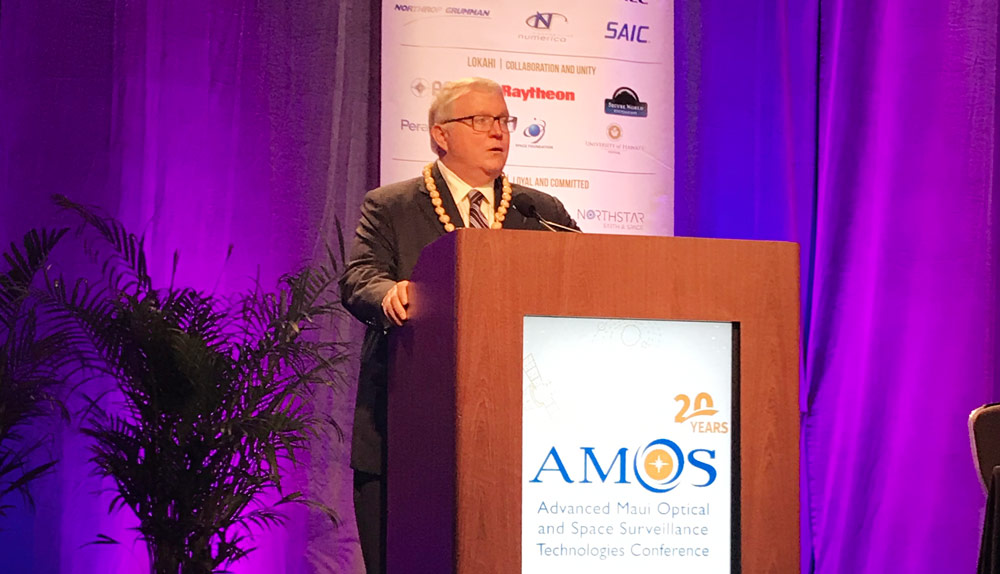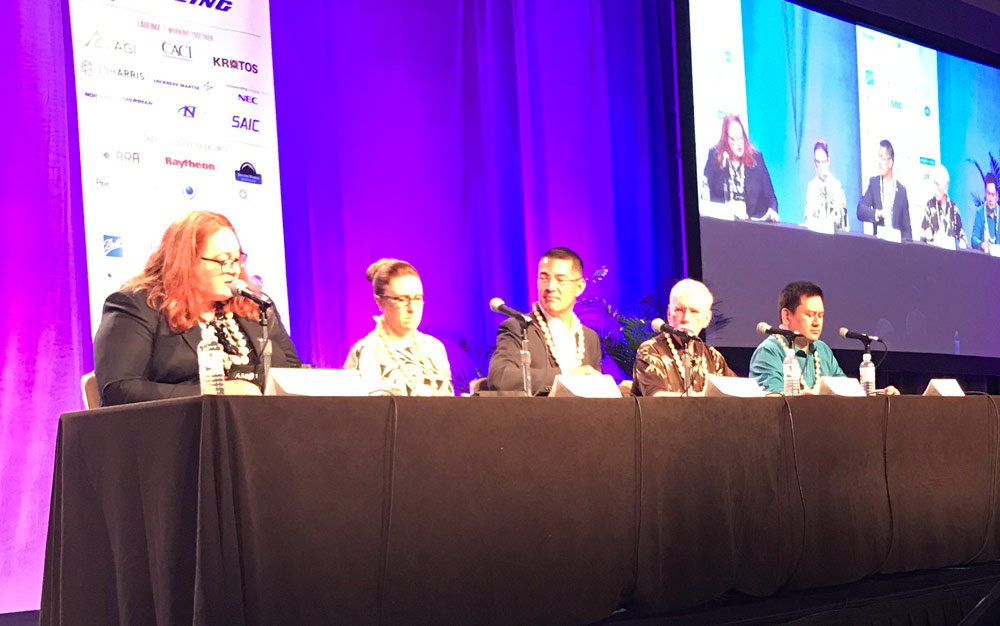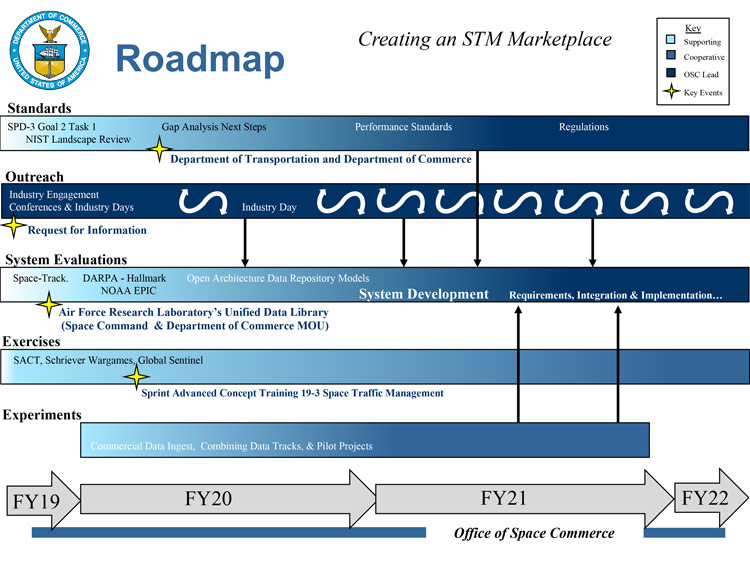Remarks from AMOS Conference 2019


On September 17-20, the Office of Space Commerce participated in the Advanced Maui Optical and Space Surveillance Technology Conference (AMOS), a major technical conference on space situational awareness (SSA).
On September 19, Diane Howard spoke on a panel on “Oversight of Satellite Constellations: Licensing and Norms.”
On September 20, OSC Director Kevin O’Connell delivered a keynote address about the Commerce Department’s efforts on an open architecture data repository for SSA data.
Following those remarks, Mark Mulholland served on a panel on “SSA Data Sharing and Open Data Repositories.”
AMOS 20th Anniversary Workshop
Keynote Remarks of Kevin O’Connell
Director, Office of Space Commerce
Wailea, Maui, Hawaii – September 20, 2019
(As prepared for delivery)
Good morning! Mahalo for the opportunity to speak to the Amos community once again!
When I spoke to you last year, I had only been in my job at the Department of Commerce for about eight weeks, so I look forward to updating you this morning on our efforts and providing you a vision of our plan for the next two years as we take on an important part of the SSA/STM mission.
Let me begin with some other important Department of Commerce business. When my office was created over 30 years ago, the central idea was to leverage the entire department on behalf of the U.S. commercial space industry. The same logic holds today.
Let me again recognize the outstanding work of the Maui Economic Development Board and the extraordinary efforts of Leslie Wilkins, Sandy Ryan, and the entire team. Many have hailed their contributions in this 20th year of AMOS. What you may not know, however, is that the Maui Economic Development Board is also a winner of one of the 2019 Regional Innovation Grants from the Economic Development Administration, our sister organization within the Department of Commerce. They were one of 26 awardees out of a pool of 140 across the nation, and this particular award was made under criteria for space commerce: far beyond AMOS, the MEDB is working to grow Hawaii’s space economy through outreach like Emergen and other educational programs to reach over 2000 secondary students across the state. They are also partnering with Hawaii’s commercial space companies to launch work-based learning and apprenticeship programs. Will you join me in congratulating them for the award and all those great efforts!
So let’s turn to the topic of space safety and reliability. When I spoke to you last year, Space Policy Directive-3 was only a few months old. Across the U.S. government, we are working in pretty intense discussions about how to advance science and technology related to SSA and STM, working to harness standards and best practices about space safety, and especially to understand how entrepreneurs can quickly help “disrupt” the space debris problem. We’re working on the concept of “basic services” — the public safety mission as discussed in SPD-3 — and how they might change in a world of overall improved SSA capability and a world with new, commercial, value added services.
So if you’ll allow me to reflect on the past year for a moment, let me offer appreciation for the assistance that many of you have provided as we make this important mission transition.
First of all to the commercial firms — some space-oriented, some from a much wider set of business organizations — who have come forward to provide ideas and solutions that will help mitigate the space debris challenge and help us clear a path for the future space economy. Many of you have heard me mention the responses to our Request for Information from earlier this year. We’re planning an industry day around that sometime later this year. Let me also give a shout out to the newly announced Space Safety Coalition for their efforts, another strong signal that satellite operators recognize the economic importance of space safety and sustainability.
Second, to our partners in the Department of Defense. They have encouraged our efforts and provided a wide range of support as we prepare for our civil agency transition. They have welcomed our colleague Mark Daley, the Department’s lead at Vandenberg, provided access to the Unified Data Library, and allowed us to participate in exercises designed to showcase the diverse capabilities in the private sector. Last year, we took Secretary Ross to Vandenberg just to see first hand the current system and discuss opportunities for modernization.
Third, to our international friends and allies. It is very exciting to see the large international presence here at AMOS, a total of 18 countries. This past June, we celebrated the adoption of 21 Long-term Sustainability Guidelines at the UN Committee on the Peaceful Uses of Outer Space, partly based on a recognition of the growing role of the private sector in space. Closer to home, many of our allies and partners have come through our doors — at Commerce, here at AMOS and at other events around the globe— to understand our efforts, offer advice, and provide new ideas about partnerships, including how to leverage their own innovative capabilities. Some of you attended our joint DoC-State Department-sponsored Space Enterprise Summit in late June in Washington, where partnerships on SSA/STM were discussed in a number of sessions.
Last but not least, to my newly formed team at Commerce that is focused on SSA/STM. This audience has already heard from Dr. Diane Howard, Chief Counsel to the Office, and Mark Mulholland, long a lead analyst for NOAA on SSA/STM. Adele Luta joins us as a Presidential Innovation fellow with deep relevant technical experience. This small team gets to leverage additional Commerce resources, whether through our dedicated “Space Team” or through the deep technical expertise of organizations like NIST, NOAA, and NTIA on spectrum. Of course, SPD-3 defines radio frequency interference as another aspect of space debris that we will have to worry about.
Sometimes there’s a real benefit to speaking near the end of a conference. We’ve had incredibly interesting discussions about creating a more cooperative space environment, about how to encourage greater transparency and data sharing, and about the wide range of sensors, analytic tools, and other capabilities designed to improve space safety and sustainability. There are some incredible capabilities demonstrated here in the Exhibit Hall, and we’ve met with a handful of other innovators.
We’ve been naturally focused on avoiding the harm of space debris, and General Shaw started us off by talking about convincing an adversary, every day, to fight another day. Another tool in our toolkit to help do that is the rapid growth in space commerce. In other words, beyond those very important missions, we need to also start thinking about improved SSA and STM as an enabler of the growing global space economy. Improved situational awareness and space traffic management are a key dependency for the trillion dollar space economy.
Think about it. Satellite inspection and satellite servicing are often described as an important next wave of space commerce. Improved SSA/STM will enable those capabilities, which potentially change the economics of space in fundamental ways. Developing the cislunar economy will require even a richer understanding of the space environment far beyond.
Let me close by talking about our vision for the next couple of years. It’s not a detailed plan nor does it have everything we’ll have to do. But we do see clarity in the lines of effort worth pursuing.
From the top:
On STANDARDS, we will leverage NIST’s landscape study done earlier this year and look at where there are gaps. There’s considerable work underway on standards, and we will work with our partners at FAA and other organizations to assess existing standards and those in development. Those standards could ultimately lead to new ideas about regulation, light touch, of course.
On INDUSTRY OUTREACH, we see continuous interaction with industry as new capabilities and concepts emerge, to gather industry input on standards and regulatory frameworks, and to understand trends in the commercial market.
On SYSTEM EVALUATION, we are already doing a quick evaluation of the UDL and considering many different aspects of what will become the open architecture data repository. We had an excellent panel on this yesterday, courtesy of SWF; other government programs like DARPA’s HALLMARK project and a new NOAA Program called EPIC, and others hold potentially important lessons, in addition to those being proposed from the cloud computing and other commercial industry approaches. Also as discussed here at AMOS — this one might be a good one for the graduate students in the room — there are important parallels in the commercialization of satellite imagery, weather, and, my favorite, GPS. None of these examples is perfect, but they may offer clues as to how to quickly advance both government and commercial interests in SSA/STM.
On EXERCISES: we will continue to participate in national-level activities with the purpose of including, advocating, and supporting commercial perspectives; as well as emphasize the potential role of commercial solutions
Finally, on what is referred to here as EXPERIMENTS: we hope to create our own engagements in the commercial market to evaluate utility and to test important challenges.
The bulk of these efforts will be focused on the design of the open architecture data repository. We see the OADR as the place from which to ultimately create conjunction notifications, based on the DoD “authoritative catalogue” and a wide range of commercial and allied services. It will also serve, to use a phrase oft heard here at AMOS, as a “marketplace” for innovation among diverse providers of new SSA/STM-related capabilities, with a view toward encouraging the development of a value added market.
FY 20 is going to be an important building block year as we start to accelerate toward SPD-3’s 2024 goal of a civil agency for commercial notifications and other services. Resources and focus will be key, even as we execute our other responsibilities in the Office of Space Commerce. We will continue to adopt a “Whole of Commerce” approach to this challenge. And we will continue to work with all of our partners for insights on how to create a truly modern SSA system that improves coordination in space.
It is both an interesting and important time to work in the space business. In addition to the very important mission of avoiding space debris, and creating new ones, improving SSA and STM is one of the key enablers of a rapidly growing commercial space economy and ensuring the safety, security and operational sustainability of outer space for the benefit all nations. I’ll look forward to updating you at the 21st AMOS conference next year. Thank you.
AMOS SSA Policy Forum
SSA Data Sharing and Open Data Repositories
Mark Mulholland, Office of Space Commerce
(Opening statement as delivered)

The description: “The growing number of space actors and activities is driving increased demand for better quality SSA data and products. This in turn is creating interest in pooling different sources of data together in ways that are openly accessible to many different users. This panel will discuss the value of such open data repositories, what characteristics are essential for their success, and what challenges will need to be overcome in creating them and building trust with users.”
Before I begin, in the spirit of Space Situational Awareness, I have two real-time observations to report:
- My fellow panel members represent the current and future of the SSA data sharing enterprise: The Department of Defense, mature space agencies such as CNES and emerging space agencies such as The Philippines.
- I also observed that the font size of each panel member’s opening remarks is directly proportional to their age!
It’s an understatement for me to state how great is it to be back to AMOS and to renew many professional and personal friendships going back many years. Thanks to the Maui Economic Development Board, the conference committee and the conference hosts for hitting it out of the park once again.
On Wednesday morning, TS Kelso did a marvelous job describing his vision for what SSA sharing would look like ten years from now.
To complement his vision, I’d like us to take a short trip down memory lane and consider the evolution of SSA sharing – I say “evolution” because I can’t pin down specific dates that these eras began and ended. I came up with these observations from a perspective of someone who has done various parts of the space traffic management and space situational awareness job in the national security, commercial and civil space sectors for a very long time. In full disclosure, I will admit that I held every one of these views at one point in time. So, a brief history of SSA sharing might look like this:
- Phase 1: “No! We aren’t sharing anything with anybody. Have a nice day.”
- Phase 2: “OK…We’ll share SSA data with you because we don’t want you to collide with our astronauts and kill them.”
- Phase 2a: “OK…We’ll share SSA information with you because we don’t want you to collide with other countries’ astronauts and kill them.”
- Phase 3: “Wow! There’s a lot of stuff up there now! We’ll help you, but only if we like you.”
- Phase 4: “Oh, no! There are companies starting to do this job. Somebody tell them to stop! Bummer… We can’t tell them to stop. Let’s ignore them and maybe they will go away.”
- Phase 5: “Oh, no! There are other countries starting to do this job. What do we do about THAT? We can’t tell THEM to stop.”
- Phase 6: The Paper Era: Form 1’s, SSA Agreements, CDMs. “We will share our data, but only under strict conditions and with the ultimate constraint of ‘The JSpOC giveth and the JSpOC taketh away.’ ”
- Phase 7: Companies, consortia, and other countries offer viable alternatives to the Paper Era. Many sources of SSA data emerge. The commercial era begins.
- Phase 8: Where do we go from here? Space Policy Directive Three and visions like TS Kelso’s establish goals and objectives. Ladies and gentlemen: This is our one shot to do this right.
When I further reflected upon the questions given to the panel, I saw many parallels to the global weather forecasting enterprise. Here are just a few parallels:
If you watch The Weather Channel for more than a few minutes, the broadcast meteorologist will talk about “The European Model,” the Global Forecast Model (or GFS), or a host of other data repositories. If you look at a typical tropical storm forecast, you will see at least a dozen different predictions based on various models. During the early phases of a storm, these model runs are literally all over the map. As more data and observations are incorporated into the models, they gradually converge into a single forecast.
What is a weather model, you ask? Simply stated, it’s a data repository of observations from sensors of many types and of varying quality. This sensor data, both current and historical, is crunched by peer-reviewed algorithms over & over again into a supercomputer to produce forecast data containing the best predictions possible with the lowest uncertainty. Sensor observations are good; more sensor observations are better. Guess what? The global weather models comprise an open architecture!
Meteorologists around the world agree upon common data formats, common quality standards, common algorithms and common sensor characteristics. They meet frequently to review and update these agreements, technical parameters and forecast techniques. They share their successes and their failures. All of this is done in a spirit of openness, cooperation and of sharing results? Why? Simple: Severe weather is an equal opportunity destroyer of lives, property, and economies.
Meteorologists constantly seek to improve short and long-term forecast accuracy and reduce uncertainty in forecasts using a very disciplined and rigorous approach. Much of this work is done in universities, cooperative institutes, consortia and governmental agencies. For the work chosen to go forward, there are well-established protocols for algorithm development, peer review, testing and verification and, finally, incorporation into the operational forecast models. The weather community has understood for a very long time that no single government, company or university has cornered the market on weather forecasting. They recognize the benefits of working together.
Any company, big or small, can obtain access to this open architecture to take data they trust to produce unique products and services that their customer trust. Today, there are countless firms producing unique products for aviation, agriculture, transportation, shipping, and other industries. Individual people have access to finished forecast products as well. I can visit other countries and trust their forecasts with the same level of trust as I do our own.
I’ll conclude with a final observation: Isn’t this exactly what we’re trying to do today in the SSA and STM enterprise?
